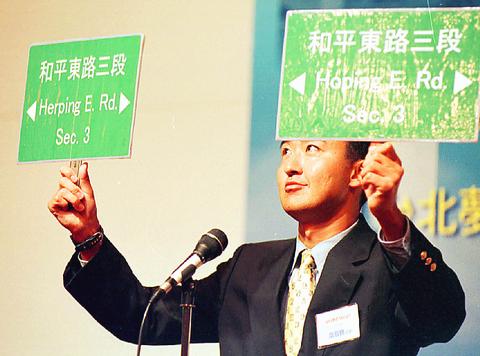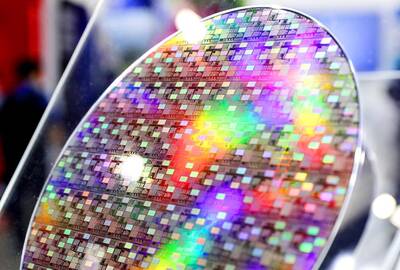The embattled Yu Bor-chuan (
During the conversation, the researcher shared with the Taipei Times the motivation behind the Tongyong Pinyin system and detailed the reasons why he believes it is a better system than China's Hanyu Pinyin (漢語拼音) for adoption in Taiwan. Most importantly, he seized the opportunity to clarify some of the issues at the heart of what he said were public misconceptions about the Tongyong system.
The 43-year-old Yu is a socio-linguist who has devoted himself for years to research interpretation and translation between English and Mandarin.

FILE PHOTO: CHIANG YING-YING, TAIPEI TIMES
Taipei Times: What led your team to invent the Tongyong Pinyin system?
Yu Bor-chuan: Inconsistencies in Mandarin Romanization have long been a contentious issue in Taiwan. Aware of the gravity of the matter and the urgency of forging an official policy, Chen Shui-bian (陳水扁), Taipei's mayor at the time, commissioned the Association of Interpretation and Translation (中華民國翻譯協會) in 1997 to standardize Mandarin Romanization for the streets of Taipei.
As a director of the association I became involved. After embarking on a series of studies, we [my teammates and myself] came to the conclusion that China's Hanyu Pinyin system was imperfect in many respects and, more significantly, that there were many aspects of the pronunciation of the assorted tongues spoken by natives of Taiwan with which it did not accord. Both of these reasons prompted my invention of the Tongyong Pinyin system.
From my point of view, Tongyong Pinyin was developed to achieve an optimal balance between internationalization and national autonomy. It will be a system accepted most easily and quickly by Taiwanese.
TT: The decision made by the Ministry of Education last Saturday to adopt the Tongyong system has sparked heated public debate. Some argue that "globalization" should be a major concern, saying that employing the Tongyong system will confuse foreigners and weaken the competitiveness of Taiwan in the international community. How do you respond to such criticism?
Yu: To achieve the goal of globalization, socio-linguists also aim to respect the heritage of minority groups.
Consider the English language, for example. Being an international language, English can be spelled and used differently from country to country. English spoken in the United Kingdom is not totally identical to that in the US, whereas Australian English has much distinctive usage that cannot be found in either the UK or the US. The differences in the use of English among these countries may be rather subtle, yet they all retain their own unique qualities.
In addition, the Cantonese Romanization system used in Hong Kong is also different from the "Cantonese spelling system" designated by the Chinese government, because Hong Kong residents have their own stance on how to normalize the spelling system of their language. Why can we not do the same to Mandarin in Taiwan?
Anyone who retains a fundamental understanding of international languages will respect Taiwan adopting its own Romanization system. To say that Taiwan will be isolated from the international community if it chooses to use the Tongyong system is to lack a full understanding of what the Tongyong system is.
In fact, the Hanyu and Tongyong systems are 85 percent similar. For the remaining 15 percent, I have improved morphemes in Hanyu Pinyin that are apparently considered flawed. With a little time and patience, learners will agree that Tongyong is user-friendly because they only have to learn four principles by heart to master the system.
Tongyong is not meant to compete with Hanyu or to replace it. The two systems can co-exist without coming into conflict.
I believe that embracing the Hanyu Pinyin system is not Taiwan's only means of keeping pace with globalization. By means of promotion by governmental departments, I believe Tongyong can also be accepted by the international community.
TT: You said you had found that the Hanyu Pinyin system was problematic in several respects. Can you give us examples? Also, would you elaborate on how Tongyong is a better system than Hanyu Pinyin when learning the languages spoken in Taiwan?
Yu: For example, "翁" is represented as "wong" in Tongyong, whereas it is spelled "weng" in Hanyu Pinyin. "Ong," rather than "eng" is a closer approximation to the phonetic value of the morphemes in the languages spoken in Taiwan.
There are three different signs in Hanyu Pinyin for the morpheme "
Furthermore, "
Another instance is that, in Hanyu, "ㄅ" is represented as "bi," while "ㄆ" is "pi." By the same token, you would assume "ㄒ" would be romanized as "si." But it is not. "Si" in Hanyu refers to the "ㄙ" sound, which is in conflict with speakers' intuitive expectations. In Hokkien, it would be easier and more natural sounding to employ the Tongyong system. "Si-gue" means watermelon, whereas "sin-iong" refers to religious belief.
As for the teaching and learning of Hakka, there is 90 percent compatibility between Tongyong and Hakka. In other words, if one knows Tongyong Pinyin one will encounter no obstacles to learning Hakka.
TT: In terms of the differences between the Tongyong and Hanyu systems, many Chinese-language newspapers have stated that the primary distinction between the two is that the former includes many local dialects and usage that would confuse foreigners. Do you consider this a fair statement?
Yu: I would like to take the chance to correct several false impressions of the Tongyong system.
Opponents of the system always cite examples of "Manka" (萬華), "Sulim," (士林) and Paronpon Street (大龍街) in Taipei City as evidence that Tongyong is a baffling system for foreign visitors because they have no background knowledge of Taiwan's history and culture.
One must understand, however, that of the more than 600 streets in Taipei, we suggested restoration of the ancient names for merely seven or eight streets, which accounts for about 1 percent of the total. For the remaining streets, the names remain absolutely unchanged. At a time when the cultural heritages of non-mainstream groups are on the verge of extinction, we consider it part of our mission to retain the names given by the Plain's Aborigines (
If people find these historic names perplexing, we do not object to using both historic and modern names. As long as maps and street signs take the same name, I am sure there would be no confusion. The most important point is standardization, how to spell is a matter of habit.

WAITING GAME: The US has so far only offered a ‘best rate tariff,’ which officials assume is about 15 percent, the same as Japan, a person familiar with the matter said Taiwan and the US have completed “technical consultations” regarding tariffs and a finalized rate is expected to be released soon, Executive Yuan spokeswoman Michelle Lee (李慧芝) told a news conference yesterday, as a 90-day pause on US President Donald Trump’s “reciprocal” tariffs is set to expire today. The two countries have reached a “certain degree of consensus” on issues such as tariffs, nontariff trade barriers, trade facilitation, supply chain resilience and economic security, Lee said. They also discussed opportunities for cooperation, investment and procurement, she said. A joint statement is still being negotiated and would be released once the US government has made

NEW GEAR: On top of the new Tien Kung IV air defense missiles, the military is expected to place orders for a new combat vehicle next year for delivery in 2028 Mass production of Tien Kung IV (Sky Bow IV) missiles is expected to start next year, with plans to order 122 pods, the Ministry of National Defense’s (MND) latest list of regulated military material showed. The document said that the armed forces would obtain 46 pods of the air defense missiles next year and 76 pods the year after that. The Tien Kung IV is designed to intercept cruise missiles and ballistic missiles to an altitude of 70km, compared with the 60km maximum altitude achieved by the Missile Segment Enhancement variant of PAC-3 systems. A defense source said yesterday that the number of

‘CRUDE’: The potential countermeasure is in response to South Africa renaming Taiwan’s representative offices and the insistence that it move out of Pretoria Taiwan is considering banning exports of semiconductors to South Africa after the latter unilaterally downgraded and changed the names of Taiwan’s two representative offices, the Ministry of Foreign Affairs (MOFA) said yesterday. On Monday last week, the South African Department of International Relations and Cooperation unilaterally released a statement saying that, as of April 1, the Taipei Liaison Offices in Pretoria and Cape Town had been renamed the “Taipei Commercial Office in Johannesburg” and the “Taipei Commercial Office in Cape Town.” Citing UN General Assembly Resolution 2758, it said that South Africa “recognizes the People’s Republic of China (PRC) as the sole

Taiwanese exports to the US are to be subject to a 20 percent tariff starting on Thursday next week, according to an executive order signed by US President Donald Trump yesterday. The 20 percent levy was the same as the tariffs imposed on Vietnam, Sri Lanka and Bangladesh by Trump. It was higher than the tariffs imposed on Japan, South Korea and the EU (15 percent), as well as those on the Philippines (19 percent). A Taiwan official with knowledge of the matter said it is a "phased" tariff rate, and negotiations would continue. "Once negotiations conclude, Taiwan will obtain a better